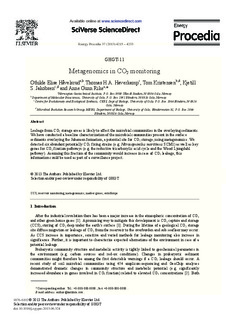| dc.contributor.author | Håvelsrud, Othilde Else | |
| dc.contributor.author | Haverkamp, Thomas Hendricus Augustus | |
| dc.contributor.author | Kristensen, Tom | |
| dc.contributor.author | Jakobsen, Kjetill Sigurd | |
| dc.contributor.author | Rike, Anne Gunn Larsen | |
| dc.date.accessioned | 2016-11-03T07:47:26Z | |
| dc.date.accessioned | 2016-12-13T09:48:49Z | |
| dc.date.available | 2016-11-03T07:47:26Z | |
| dc.date.available | 2016-12-13T09:48:49Z | |
| dc.date.issued | 2013 | |
| dc.identifier.citation | Energy Procedia 2013, 37:4215-4233 | |
| dc.identifier.issn | 1876-6102 | |
| dc.identifier.uri | http://hdl.handle.net/11250/2425007 | |
| dc.description | - | |
| dc.description.abstract | Leakage from CO2 storage areas is likely to affect the microbial communities in the overlaying sediments. We have conducted a baseline characterization of the microbial communities present in the surface sediments overlaying the Johansen formation, a potential site for CO2 storage, using metagenomics. We detected six abundant potentially CO2 fixing strains (e.g. Nitrosopumilus maritimus SCM1) as well as key genes for CO2 fixation pathways (e.g. the reductive tricarboxylic acid cycle and the Wood Ljungdahl pathway). Assuming this fraction of the community would increase in case of CO2 leakage; this information could be used as part of a surveillance project. | |
| dc.language.iso | eng | |
| dc.title | Metagenomics in CO2 Monitoring | |
| dc.type | Journal article | |
| dc.date.updated | 2016-11-03T07:47:26Z | |
| dc.identifier.doi | 10.1016/j.egypro.2013.06.324 | |
| dc.identifier.cristin | 1062666 | |
| dc.relation.project | Norges forskningsråd: 179569 | |
